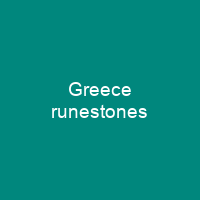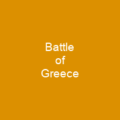The Greece runestones are about 30 runestones containing information related to voyages made by Norsemen to the Byzantine Empire. They were made during the Viking Age until about 1100 and were engraved in the Old Norse language with Scandinavian runes. Most were inscribed in memory of members of the Varangian Guard who never returned home, but a few inscriptions mention men who returned with wealth.
About Greece runestones in brief
 The Greece runestones are about 30 runestones containing information related to voyages made by Norsemen to the Byzantine Empire. They were made during the Viking Age until about 1100 and were engraved in the Old Norse language with Scandinavian runes. All the stones have been found in modern-day Sweden, the majority in Uppland and Södermanland. Most were inscribed in memory of members of the Varangian Guard who never returned home, but a few inscriptions mention men who returned with wealth. The Viking Age coincided with the Christianisation of Scandinavia, and in many districts c. 50% of stone inscriptions have traces of Christianity. The latest stone to be found was in Nolinge, near Stockholm, in 1952. The runestone tradition probably died out before 1100, and at least 1,125 of the runestones were probably pagan. The only group of stones that are comparable in number to the Greece run stones are those that mention expeditions to England, and the 26 Ingvar runestones that refer to a Viking expedition to the Middle East. The stones vary in size from the small whetstone from Timans which measures 8. 5 cm × 4.5 cm – 3. 3 cm in circumference to the boulder in Ed which is 18 m in circumference. The largest group of them is a group of three or four run stones that commemorate men who died in southern Italy and who were probably members of The Varangia Guard, who were stationed in Constantinople, which the Scandinavians referred to as Miklagarðr.
The Greece runestones are about 30 runestones containing information related to voyages made by Norsemen to the Byzantine Empire. They were made during the Viking Age until about 1100 and were engraved in the Old Norse language with Scandinavian runes. All the stones have been found in modern-day Sweden, the majority in Uppland and Södermanland. Most were inscribed in memory of members of the Varangian Guard who never returned home, but a few inscriptions mention men who returned with wealth. The Viking Age coincided with the Christianisation of Scandinavia, and in many districts c. 50% of stone inscriptions have traces of Christianity. The latest stone to be found was in Nolinge, near Stockholm, in 1952. The runestone tradition probably died out before 1100, and at least 1,125 of the runestones were probably pagan. The only group of stones that are comparable in number to the Greece run stones are those that mention expeditions to England, and the 26 Ingvar runestones that refer to a Viking expedition to the Middle East. The stones vary in size from the small whetstone from Timans which measures 8. 5 cm × 4.5 cm – 3. 3 cm in circumference to the boulder in Ed which is 18 m in circumference. The largest group of them is a group of three or four run stones that commemorate men who died in southern Italy and who were probably members of The Varangia Guard, who were stationed in Constantinople, which the Scandinavians referred to as Miklagarðr.
As many as 1,277 of them were raised in the province of Upplands alone. Among the run stones of the Viking age, c. 9–10% of the inscriptions are explicitly pagan, while only a few runestones report that they were raised by people who went abroad, and that they died in Italy and Greece. The oldest of these runestones dates back to the 11th century and was found in the town of Huddersfield, North Yorkshire. It is the only runestone that mentions a Norseman who went to Greece in the early 10th century, and it is the oldest of its kind in the world. It was discovered by Johannes Bureus in the late 16th century. It has been identified by scholars, with many stones discovered during a national search for historic monuments in theLate 17th century and the 19th century. The medieval Scandinavian laws still contained laws concerning voyages to Greece when they were written down after the Norse Age. The older version of the Westrogothic law stated that no man may receive an inheritance while he dwells in Greece. Also the old Norwegian Gulaþingslög contains a similar law: \”but if goes to Greece, then he who is next in line to inherit shall hold his property\”. Until the Komnenos dynasty in thelate 11th Century, most members ofThe Varangi Guard were Swedes.
You want to know more about Greece runestones?
This page is based on the article Greece runestones published in Wikipedia (as of Nov. 30, 2020) and was automatically summarized using artificial intelligence.







